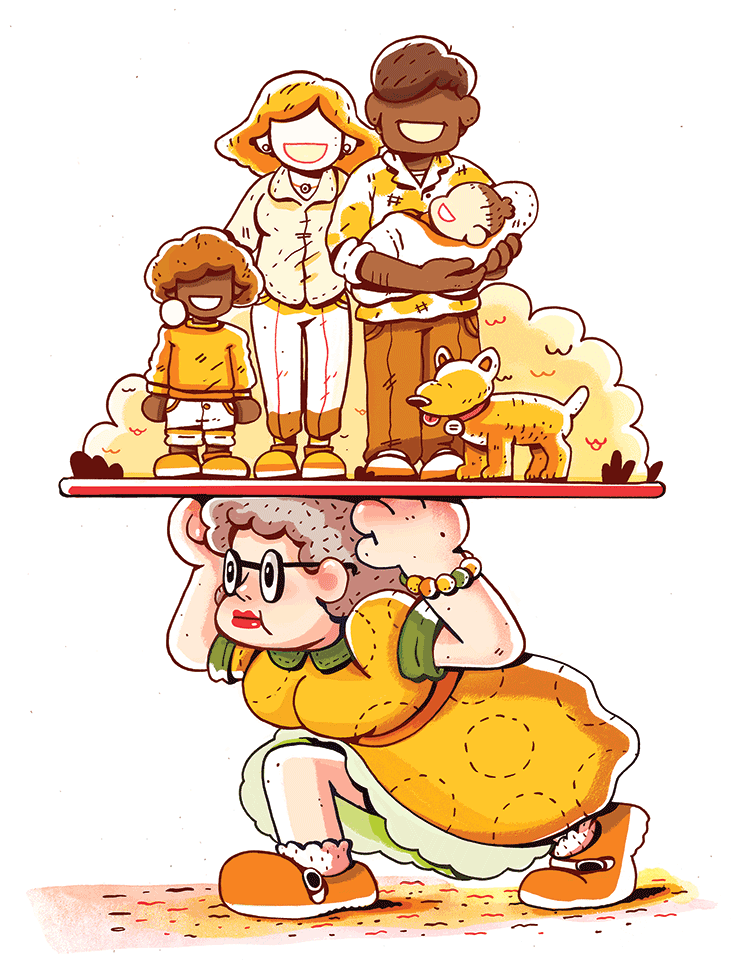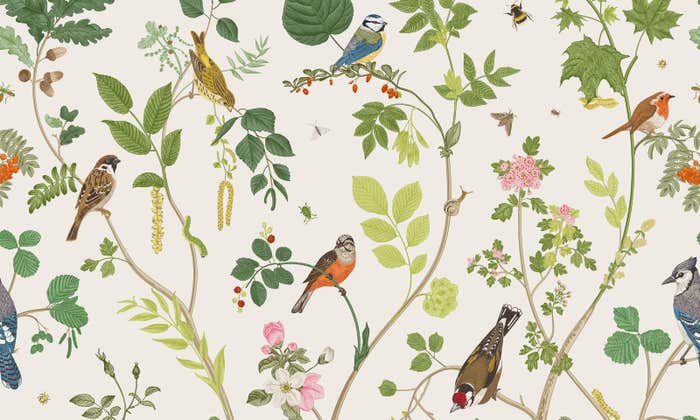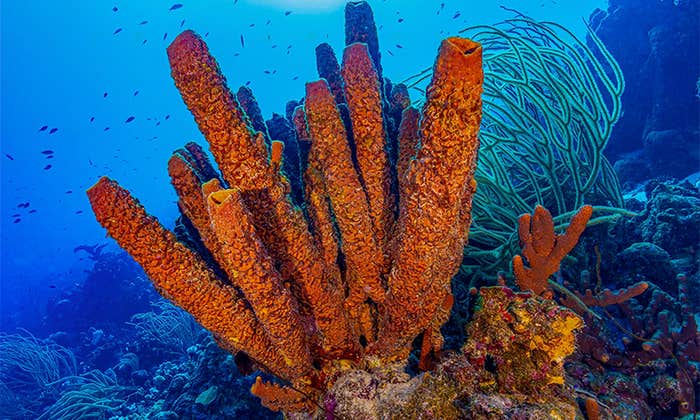Grandparents are busy these days. The number of juveniles in the United States under 18 living in a grandparent’s household rose from 4.6 million in 2005-07 to 5.2 million in 2008-10, probably because of economic stress associated with the Great Recession.1 Thirteen percent of grandparents provide regular care for at least one grandchild, and 62 percent have provided financial support of some kind to their grandchildren within the past five years.2
These circumstances can be stressful for youngsters, their parents, and their grandparents. But there is another way of looking at it: Today’s grandparents are doing exactly what their biology has prepared them for.

In pretty much all other species, individuals reproduce until they can’t anymore, and nearly always, this coincides with the end of their lives. Human beings are extraordinary, by contrast, in that long after we’ve stopped reproducing, we just keep on living. In particular, we appear to be the only animals in which half the population loses the ability to reproduce, through menopause, while they still have roughly one-third of their lives ahead of them, much of it quite healthy.
Natural selection rewards reproduction, and the mathematics show that a woman who produces an additional child will be favored over one who stops ovulating. (Reproduction offers the biological equivalent of compound interest; having just one more offspring means the potential of a whole lot of enhanced fitness, so selection should always favor giving it one more try, even if the would-be mother dies in the attempt.) As a result, the existence of menopause as a species-wide trait presents a species-wide mystery. Why don’t people, like other perfectly good mammals, keep on reproducing until they die? Or, another way of looking at it, why do women stop reproducing in late middle age, and yet keep on living? The answer that is emerging from a productive confluence of evolutionary theory and anthropology is that these old people—too old to reproduce, too young and healthy to kick the bucket—are highly biologically relevant.3
Why, specifically, do our bodies begin wearing out so early compared to their potential lifespan, and why is women’s reproductive function particularly targeted? Why don’t kidneys similarly give up and shut down at age 50? Or lungs? The targeting of reproduction is especially perplexing since evolution rewards breeding above all else. Baby-making should be among the last things to go. Not only that, but modern techniques of artificial fertilization have made it possible for women in their 50s and even 60s to sustain pregnancy and bear healthy babies, showing that an aging female body can be up to the task.
Maybe women stop ovulating and menstruating around age 50 because they simply run out of eggs. After all, every girl is born with about 400 eggs, which are ovulated—roughly one per month—for approximately 35 years. But each XX embryo starts off with about 6 million primordial germ cells, and natural selection has generated all sorts of remarkable adaptations in other respects. There’s no reason to think that evolution wouldn’t be capable of endowing a woman with 500 or even 1,000 viable eggs if she could make good use of them.
We’re left with the likelihood that menopause is almost certainly adaptive.
Or maybe old is new and evolution just hasn’t had a chance to keep up with our newfound longevity. After all, the average lifespan during most of our evolutionary past was considerably shorter than it is today. The truth is more complex, however. Most of the increased average lifespan that modern human beings enjoy today is a result of reductions in infant mortality. If one baby died at birth for every one who made it to age 60, the average lifespan would be 30, but there would still be plenty of 60-year-olds. Even some octogenarians. Moreover, for contemporary hunter-gatherer-forager people today, life expectancy at age 20 is about 70 years, two decades or so after menopause.4 Almost certainly, there were old people in our past, just as there are today.
If only by process of elimination, we’re left with the likelihood that menopause—the persistence of non-reproductive, elderly life—is not an illness, or something random, or a consequence of long modern lifespans. Nor is it testimony to evolution’s lack of foresight, with natural selection somehow forgetting to fill ’er up with enough follicles. Rather, it is almost certainly adaptive, something that has been produced by natural selection because it benefits its possessors. But what’s the payoff?
Consider, first, that natural selection isn’t simply focused on producing as many children as possible. “Fitness” is a matter of projecting genes into the future, or, to put it more accurately, genes successfully promoting copies of themselves. Putting those genes in one’s offspring is an efficient route, but so would be employing other bodies, with the importance of such bodies decreasing as they are more distantly related. This is the basic principle underlying “inclusive fitness theory,” first clearly articulated by the late William D. Hamilton, and now one of the cornerstones of modern evolutionary biology.
Even if we consider only traditional Darwinian fitness—offspring—the issue isn’t simply how many a woman generates, but how many are actually successful. Successful at what? Reproducing. Accordingly, offspring are evolutionarily important insofar as they, in turn, make their own offspring—that is, grandchildren. (Of course, this keeps going indefinitely into subsequent generations—but for the sake of understanding the process, grandchildren are enough.)
Let’s consider, now, one of our great-great-great … grandmothers. She is middle-aged, having produced, say, four children of whom two have survived to young adulthood. These two children are now about to become parents. What is the best, most fitness-enhancing thing that our middle-aged ancestral woman, their mother, can do? One possibility is that she could keep on having more children, which is what essentially all other mammals do. They breed ‘till they drop. A problem with this strategy is that pregnancy, childbirth, and lactation are physiologically taxing, stresses that younger individuals can usually deal with quite well, but that generate increased morbidity and mortality as any would-be mother ages. (Even with the benefit of modern obstetrics, a woman over the age of 40 has a seven times greater risk of dying in childbirth than a 20-year-old does.)5 So, our middle-aged momma could keep at it, maybe succeeding and maybe dying in the attempt. A naive view, based simply on reproductive arithmetic, suggests that she’s better off (more fit, evolutionarily) if she tries than if she doesn’t, simply because sometimes she’d succeed. But she might not just die trying; her loss might also mean that any of her young, dependent offspring would be deprived of her mothering, and this would actively diminish her fitness compared to a mother who refrained from having just one more child.
Why don’t people, like other perfectly good mammals, keep on reproducing until they die?
Among Jane Goodall’s famous chimpanzees, the gloriously maternal Flo produced a youngster, Flint, in her old age. Flint wasn’t quite weaned when Flo did it yet again, becoming mother to Flame. Shortly after, Flame died and so did Flo, perhaps because of the stress pregnancy and lactation imposed on her. In any event, Flint was left an orphan and he died within a month of losing his mother.
Flo wasn’t an evolutionary failure. She had already produced three flourishing offspring, themselves reproductive. But she would have been even more successful if her body had “just said No” after Flint and before Flame. Primatologist Sarah Hrdy contemplated the sad case of Flo and her too-persistent reproduction, coming up with the “Prudent Mother Hypothesis.” It suggests that menopause is a way that natural selection ensures that human beings, at least, don’t make the same mistake. “Stopping early,” according to Hrdy, “guarantees that old mothers who give birth to one last baby will care for it long enough to see this reproductive enterprise through to a successful conclusion.”6
But why does evolution impose this order only upon human beings, and not chimpanzees, or other primates? These days, evolutionary biologists are increasingly convinced that the answer has a lot to do with another special characteristic of our species: our very long period of childhood dependency, which, in turn, is associated with how much we have to learn. Part of being a prudent mother, if you’re of the species Homo sapiens, is that your job isn’t done simply when you’ve popped out some offspring. Moreover, it isn’t finished when those offspring have grown up, or even when they’ve begun to have their own children. Rather, those children—your grandchildren—also need to be successful, and for that, it evidently helps if someone (beyond the biological parents) is around to help rear that next generation.
The Grandmother Hypothesis helps make sense of a recent and intriguing finding: A particular variant of the immunoregulatory receptor gene known as CD33 has been adjusted in human beings (compared with chimps) to be protective against late-onset Alzheimer’s disease.7 It seems reasonable that the chimpanzee equivalent of this illness, if it existed, would be disadvantageous to chimps, too, as it is in human beings. But chimpanzees don’t experience a prolonged post-reproductive lifespan like we do, and so, they haven’t undergone comparable selection to ameliorate the devastating effects of Alzheimer’s or its parallel among chimps. A fundamental evolutionary insight is that selection is relaxed after reproduction has been achieved, and indeed, this helps make sense of the phenomenon of senescence generally.
Natural selection is less potent as aging proceeds, simply because older individuals are less relevant as they have less reproductive future. This is almost certainly true for human beings, too, but apparently less so for us than for other critters. And according to the Grandmother Hypothesis, this is because, more than for other critters, old people can make a contribution to their own fitness by enhancing that of their offspring, via their grandchildren. By the same token, the fact that our species has apparently experienced selection that is at least somewhat protective against the ravages of old age suggests that even the elderly are valuable enough—purely in evolutionary terms—to warrant keeping them functional.

The Hadza are hunter-gatherers currently living in modern-day Tanzania. Although there aren’t many Hadza left (perhaps 1,000 or so), they’ve persisted in a lifestyle in which women gather and forage, while men hunt—harkening back, to some extent, to what paleo-anthropologists believe our ancient ancestors did for millennia on the African savannah. Kristen Hawkes, an anthropologist at the University of Utah, and her colleagues have found that among the Hadza, women bring in considerably more calories by foraging than men do by hunting. Not only that, but the hardest-working foragers—the ones who bring in the most calories of all—are post-menopausal women.
It’s the grandmothers who provide edible roots, who gather more than their share of fruit, and who obtain gobs of honey, which is especially valued.8 Teenagers and newly-weds forage for roughly three hours per day; married women with young children pitch in at an average of four and a half hours (it’s difficult to dig and forage when you’re also carrying a baby, never mind nursing as well). Grandmothers tip the scales at seven hours. The resulting “income” is far more than they need for themselves, and not surprisingly, they share the bounty with their children and grandchildren. Also not surprising: The body weight of grandchildren increases in proportion as their grandmothers contribute. Moreover, among the Hadza studied by Hawkes and her team, every nursing mother is supported by a post-menopausal helper, nearly always her mother or mother-in-law.
What’s true of the Hadza isn’t necessarily true for all people currently living a traditional lifestyle. Furthermore, it isn’t guaranteed that today’s gatherers and hunters offer an unobstructed view of how our early ancestors functioned. But it’s the best that we currently have, and it strongly suggests that natural selection has favored mandatory non-reproduction among middle-aged women so that they could invest in their grandchildren.
For today’s shrinking and increasingly stressed middle class, it seems that extended families are more needed than ever, as Mom and Dad have to work full time, leaving the grandparents to take up at least some of the slack when it comes to child-rearing: a modern day Hadza scenario, right here in high-tech America. The silver lining is that, in a sense, this is a return to form for the grandparent. According to the Pew Research Center, older Americans report that the best part of growing old, by far, is spending more time with family, especially grandchildren.9 A 2013 study by Boston College found that emotionally close relationships between grandparents and grandchildren are “associated with fewer symptoms of depression for both generations.”10 There’s also a growing granny labor pool: The numbers of U.S. grandparents are at record highs, and growing faster than the general population. By 2020, they are projected to represent nearly 1-in-3 adults.11 They are also close by, with 69 percent living within 50 miles of their closest grandchildren.12
Thank goodness that they aren’t burdened with their own young children and are available to pitch in, Hadza-style.
David P. Barash is an evolutionary biologist and professor of psychology at the University of Washington; his most recent book is Out of Eden: Surprising Consequences of Polygamy (2016, Oxford University Press).
References
1. Murphey, D., Cooper, M., & Moore, K.A. Children living with and cared for by grandparents: State-level data from the American community survey. Child Trends Research Brief (2012).
2. Grandparents Investing in Grandchildren: The MetLife study on how grandparents share their time, values, and money. MetLife Mature Market Institute (2012).
3. Barash, D.P. & Lipton, J.E. How Women Got Their Curves and Other Just-So Stories: Evolutionary Enigmas Columbia University Press, New York, NY (2009).
4. Gurven, M. & Kaplan, H. Longevity among hunter-gatherers: A cross- cultural examination. Population and Development Review 33, 321–365 (2007).
5. Restrepo-Méndez, M.C. & Victora, C.G. Maternal mortality by age: who is most at risk? The Lancet Global Health 2, e120-e121 (2014).
6. Hrdy, S.B. Mother Nature: Maternal Instincts and How They Shape The Human Species Ballantine Books, New York, NY (1999).
7. Schwarz, F., et al. Human-specific derived alleles of CD33 and other genes protect against postreproductive cognitive decline. Proceedings of the National Academy of Sciences 113, 74–79 (2016).
8. Hawkes, K., O’Connell, J.F., & Blurton Jones, N.G. Hadza women’s time allocation, offspring provisioning and the evolution of long postmenopausal life spans. Current Anthropology 38, 551–578 (1997).
9. Krogstad, J.M. 5 Facts About American Grandparents. PewResearch.org (2015).
10. Strong grandparent-adult grandchild relationships reduce depression for both. American Sociological Association, EurekAlert.org (2013).
11. The MetLife Report on American Grandparents: New insights for a new generation of grandparents. MetLife Mature Market Institute (2011).
12. Lampkin, C.L. Insights and spending habits of modern grandparents. AARP Research (2012).























